Networking Infrastructure Report: BTEC Level 5 HND Computing
VerifiedAdded on 2022/03/21
|31
|4931
|24
Report
AI Summary
This report is a comprehensive solution for a BTEC Level 5 HND Diploma in Computing, Unit 2: Networking Infrastructure assignment. It covers key learning outcomes, including examining networking principles and protocols (LO1), explaining networking devices and operations (LO2), designing efficient networked systems (LO3), and implementing and diagnosing networked systems (LO4). The report discusses different network types (LAN, WAN, MAN), protocols (DNS, DHCP, FTP, HTTP), and standards. It explores network topologies (mesh, star, bus, ring, tree, and hybrid) and their impact on communication and bandwidth. The report also addresses the operating principles of networking devices, server types (proxy, mail, web, application, etc.), and workstation hardware. It provides a logical/physical design of a networked system, evaluates the design, and includes a proposed maintenance schedule. The assignment showcases an implemented network, test results, and recommendations for enhancements, demonstrating a thorough understanding of networking concepts.

ASSIGNMENT
Qualification BTEC Level 5 HND Diploma in Computing
Unit number and title Unit 2: Networking Infrastructure
Submission date Date Received 1st submission
Re-submission Date Date Received 2nd submission
Student Name LE XUAN PHU Student ID BSBF190029
Class Assessor name ĐỖ PHI HƯNG
Student declaration
I certify that the assignment submission is entirely my own work and I fully understand the consequences of plagiarism. I understand that
making a false declaration is a form of malpractice.
Student’s signature
Grading gri
Page 1
Qualification BTEC Level 5 HND Diploma in Computing
Unit number and title Unit 2: Networking Infrastructure
Submission date Date Received 1st submission
Re-submission Date Date Received 2nd submission
Student Name LE XUAN PHU Student ID BSBF190029
Class Assessor name ĐỖ PHI HƯNG
Student declaration
I certify that the assignment submission is entirely my own work and I fully understand the consequences of plagiarism. I understand that
making a false declaration is a form of malpractice.
Student’s signature
Grading gri
Page 1
Paraphrase This Document
Need a fresh take? Get an instant paraphrase of this document with our AI Paraphraser
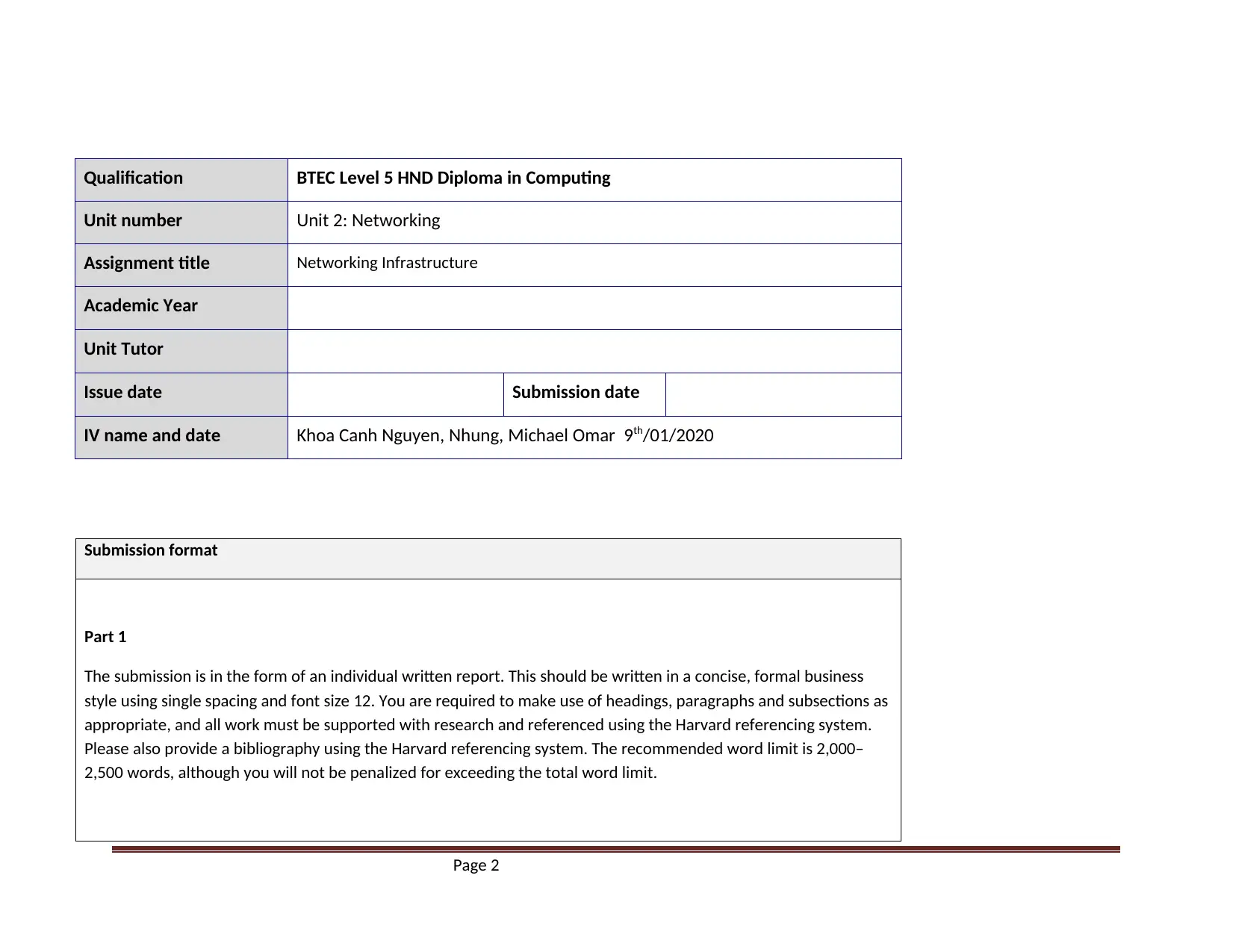
Qualification BTEC Level 5 HND Diploma in Computing
Unit number Unit 2: Networking
Assignment title Networking Infrastructure
Academic Year
Unit Tutor
Issue date Submission date
IV name and date Khoa Canh Nguyen, Nhung, Michael Omar 9th/01/2020
Submission format
Part 1
The submission is in the form of an individual written report. This should be written in a concise, formal business
style using single spacing and font size 12. You are required to make use of headings, paragraphs and subsections as
appropriate, and all work must be supported with research and referenced using the Harvard referencing system.
Please also provide a bibliography using the Harvard referencing system. The recommended word limit is 2,000–
2,500 words, although you will not be penalized for exceeding the total word limit.
Page 2
Unit number Unit 2: Networking
Assignment title Networking Infrastructure
Academic Year
Unit Tutor
Issue date Submission date
IV name and date Khoa Canh Nguyen, Nhung, Michael Omar 9th/01/2020
Submission format
Part 1
The submission is in the form of an individual written report. This should be written in a concise, formal business
style using single spacing and font size 12. You are required to make use of headings, paragraphs and subsections as
appropriate, and all work must be supported with research and referenced using the Harvard referencing system.
Please also provide a bibliography using the Harvard referencing system. The recommended word limit is 2,000–
2,500 words, although you will not be penalized for exceeding the total word limit.
Page 2
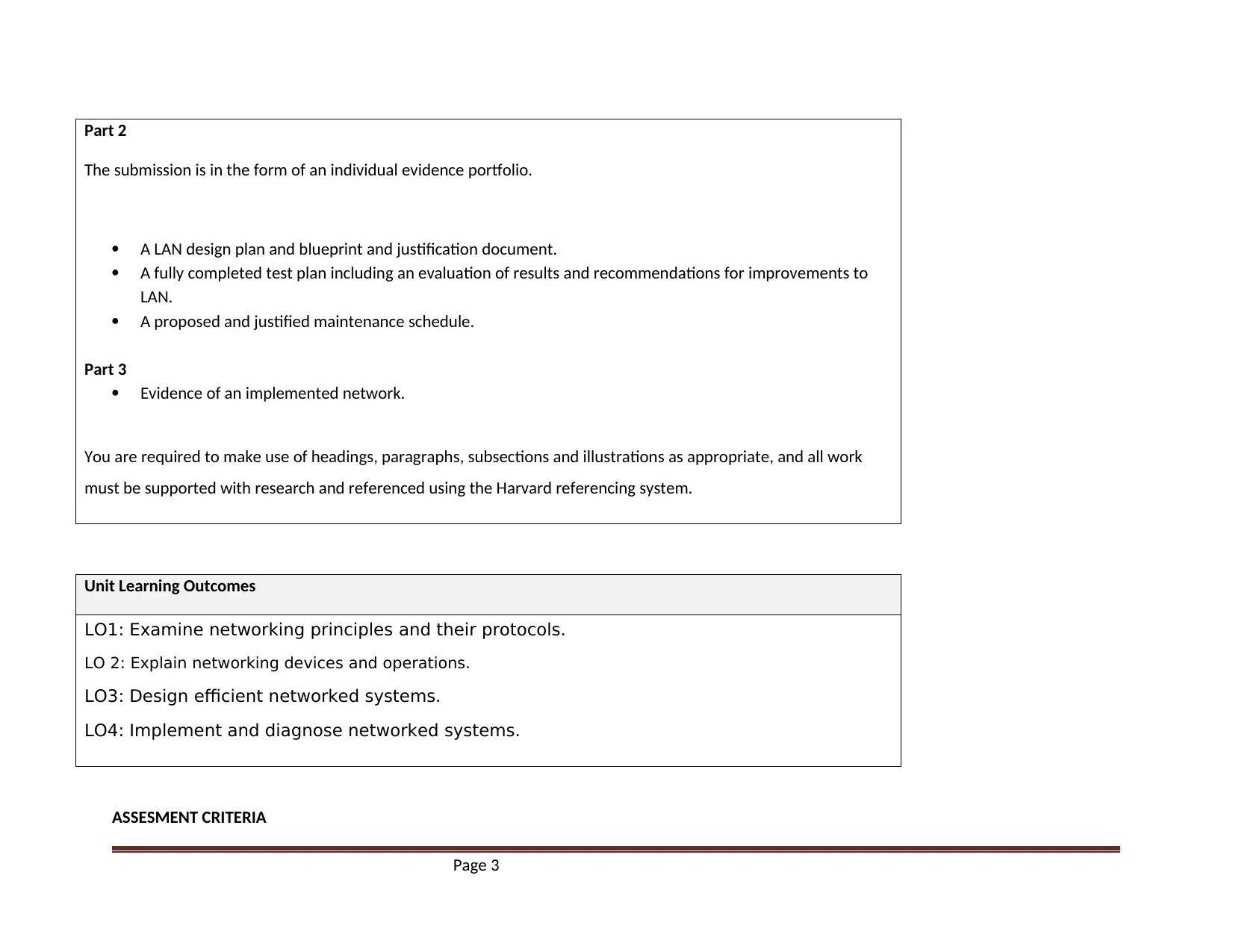
Part 2
The submission is in the form of an individual evidence portfolio.
A LAN design plan and blueprint and justification document.
A fully completed test plan including an evaluation of results and recommendations for improvements to
LAN.
A proposed and justified maintenance schedule.
Part 3
Evidence of an implemented network.
You are required to make use of headings, paragraphs, subsections and illustrations as appropriate, and all work
must be supported with research and referenced using the Harvard referencing system.
Unit Learning Outcomes
LO1: Examine networking principles and their protocols.
LO 2: Explain networking devices and operations.
LO3: Design efficient networked systems.
LO4: Implement and diagnose networked systems.
ASSESMENT CRITERIA
Page 3
The submission is in the form of an individual evidence portfolio.
A LAN design plan and blueprint and justification document.
A fully completed test plan including an evaluation of results and recommendations for improvements to
LAN.
A proposed and justified maintenance schedule.
Part 3
Evidence of an implemented network.
You are required to make use of headings, paragraphs, subsections and illustrations as appropriate, and all work
must be supported with research and referenced using the Harvard referencing system.
Unit Learning Outcomes
LO1: Examine networking principles and their protocols.
LO 2: Explain networking devices and operations.
LO3: Design efficient networked systems.
LO4: Implement and diagnose networked systems.
ASSESMENT CRITERIA
Page 3
⊘ This is a preview!⊘
Do you want full access?
Subscribe today to unlock all pages.

Trusted by 1+ million students worldwide
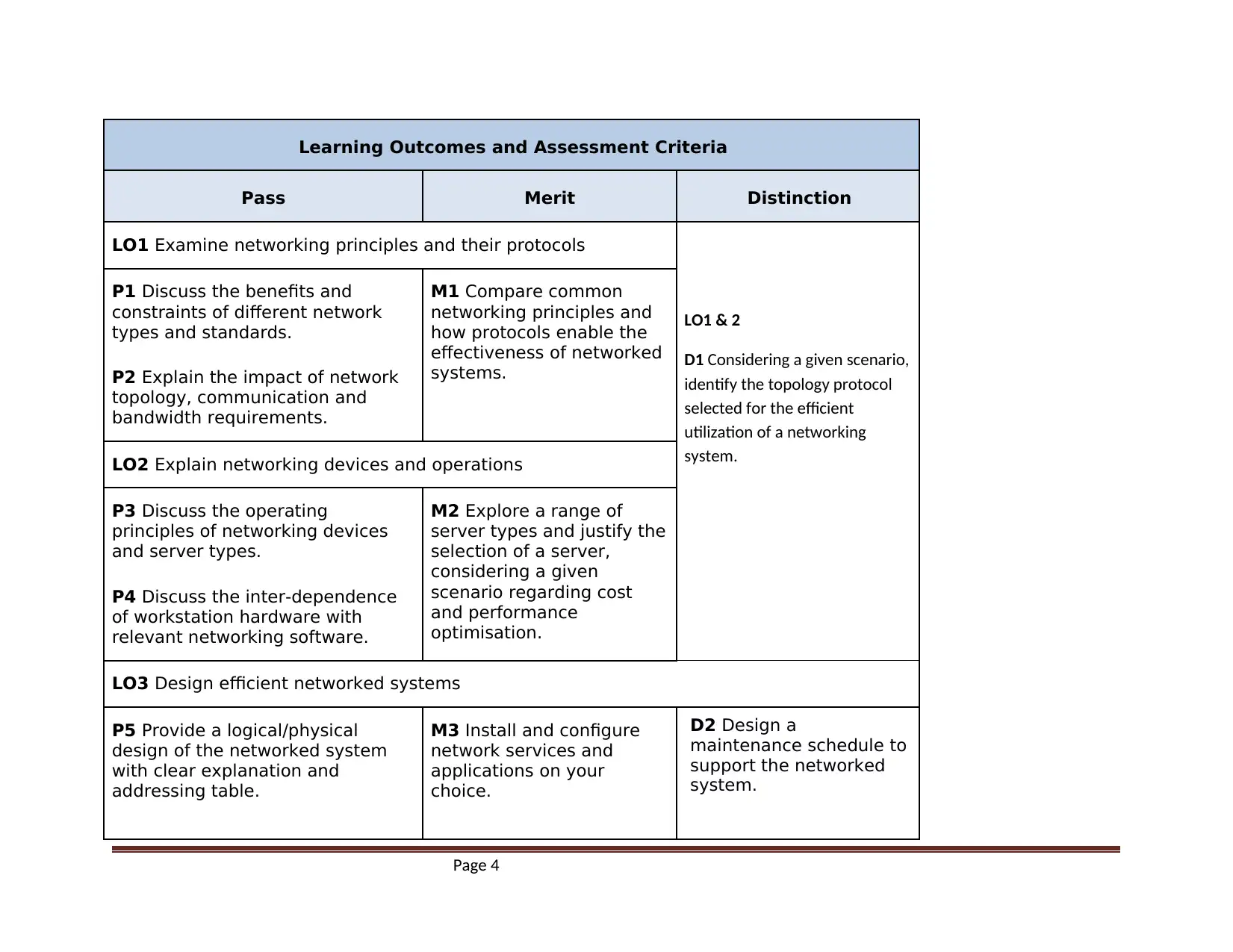
Learning Outcomes and Assessment Criteria
Pass Merit Distinction
LO1 Examine networking principles and their protocols
LO1 & 2
D1 Considering a given scenario,
identify the topology protocol
selected for the efficient
utilization of a networking
system.
P1 Discuss the benefits and
constraints of different network
types and standards.
P2 Explain the impact of network
topology, communication and
bandwidth requirements.
M1 Compare common
networking principles and
how protocols enable the
effectiveness of networked
systems.
LO2 Explain networking devices and operations
P3 Discuss the operating
principles of networking devices
and server types.
P4 Discuss the inter-dependence
of workstation hardware with
relevant networking software.
M2 Explore a range of
server types and justify the
selection of a server,
considering a given
scenario regarding cost
and performance
optimisation.
LO3 Design efficient networked systems
P5 Provide a logical/physical
design of the networked system
with clear explanation and
addressing table.
M3 Install and configure
network services and
applications on your
choice.
D2 Design a
maintenance schedule to
support the networked
system.
Page 4
Pass Merit Distinction
LO1 Examine networking principles and their protocols
LO1 & 2
D1 Considering a given scenario,
identify the topology protocol
selected for the efficient
utilization of a networking
system.
P1 Discuss the benefits and
constraints of different network
types and standards.
P2 Explain the impact of network
topology, communication and
bandwidth requirements.
M1 Compare common
networking principles and
how protocols enable the
effectiveness of networked
systems.
LO2 Explain networking devices and operations
P3 Discuss the operating
principles of networking devices
and server types.
P4 Discuss the inter-dependence
of workstation hardware with
relevant networking software.
M2 Explore a range of
server types and justify the
selection of a server,
considering a given
scenario regarding cost
and performance
optimisation.
LO3 Design efficient networked systems
P5 Provide a logical/physical
design of the networked system
with clear explanation and
addressing table.
M3 Install and configure
network services and
applications on your
choice.
D2 Design a
maintenance schedule to
support the networked
system.
Page 4
Paraphrase This Document
Need a fresh take? Get an instant paraphrase of this document with our AI Paraphraser

P6 Evaluate the design to meet
the requirements.
LO4 Implement and diagnose networked systems
P7 Implement a networked system
based on a prepared design.
P8 Document and analyse test
results against expected results.
M4 Recommend potential
enhancements for the
networked systems.
D3 Use critical reflection
to evaluate own work and
justify valid conclusions.
Page 5
the requirements.
LO4 Implement and diagnose networked systems
P7 Implement a networked system
based on a prepared design.
P8 Document and analyse test
results against expected results.
M4 Recommend potential
enhancements for the
networked systems.
D3 Use critical reflection
to evaluate own work and
justify valid conclusions.
Page 5
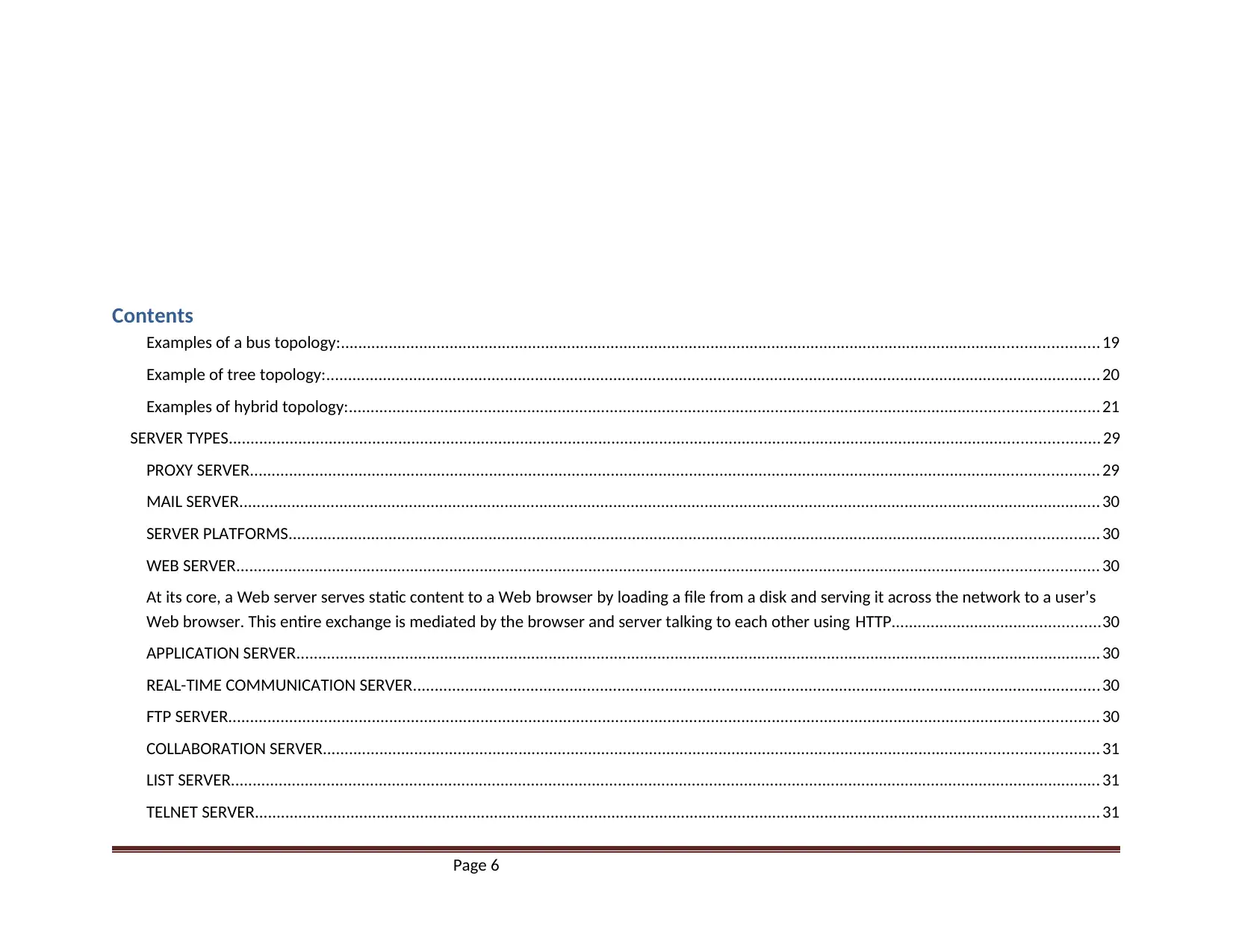
Contents
Examples of a bus topology:.............................................................................................................................................................................. 19
Example of tree topology:.................................................................................................................................................................................. 20
Examples of hybrid topology:............................................................................................................................................................................ 21
SERVER TYPES........................................................................................................................................................................................................ 29
PROXY SERVER................................................................................................................................................................................................... 29
MAIL SERVER...................................................................................................................................................................................................... 30
SERVER PLATFORMS.......................................................................................................................................................................................... 30
WEB SERVER...................................................................................................................................................................................................... 30
At its core, a Web server serves static content to a Web browser by loading a file from a disk and serving it across the network to a user’s
Web browser. This entire exchange is mediated by the browser and server talking to each other using HTTP................................................30
APPLICATION SERVER......................................................................................................................................................................................... 30
REAL-TIME COMMUNICATION SERVER..............................................................................................................................................................30
FTP SERVER........................................................................................................................................................................................................ 30
COLLABORATION SERVER.................................................................................................................................................................................. 31
LIST SERVER........................................................................................................................................................................................................ 31
TELNET SERVER.................................................................................................................................................................................................. 31
Page 6
Examples of a bus topology:.............................................................................................................................................................................. 19
Example of tree topology:.................................................................................................................................................................................. 20
Examples of hybrid topology:............................................................................................................................................................................ 21
SERVER TYPES........................................................................................................................................................................................................ 29
PROXY SERVER................................................................................................................................................................................................... 29
MAIL SERVER...................................................................................................................................................................................................... 30
SERVER PLATFORMS.......................................................................................................................................................................................... 30
WEB SERVER...................................................................................................................................................................................................... 30
At its core, a Web server serves static content to a Web browser by loading a file from a disk and serving it across the network to a user’s
Web browser. This entire exchange is mediated by the browser and server talking to each other using HTTP................................................30
APPLICATION SERVER......................................................................................................................................................................................... 30
REAL-TIME COMMUNICATION SERVER..............................................................................................................................................................30
FTP SERVER........................................................................................................................................................................................................ 30
COLLABORATION SERVER.................................................................................................................................................................................. 31
LIST SERVER........................................................................................................................................................................................................ 31
TELNET SERVER.................................................................................................................................................................................................. 31
Page 6
⊘ This is a preview!⊘
Do you want full access?
Subscribe today to unlock all pages.

Trusted by 1+ million students worldwide
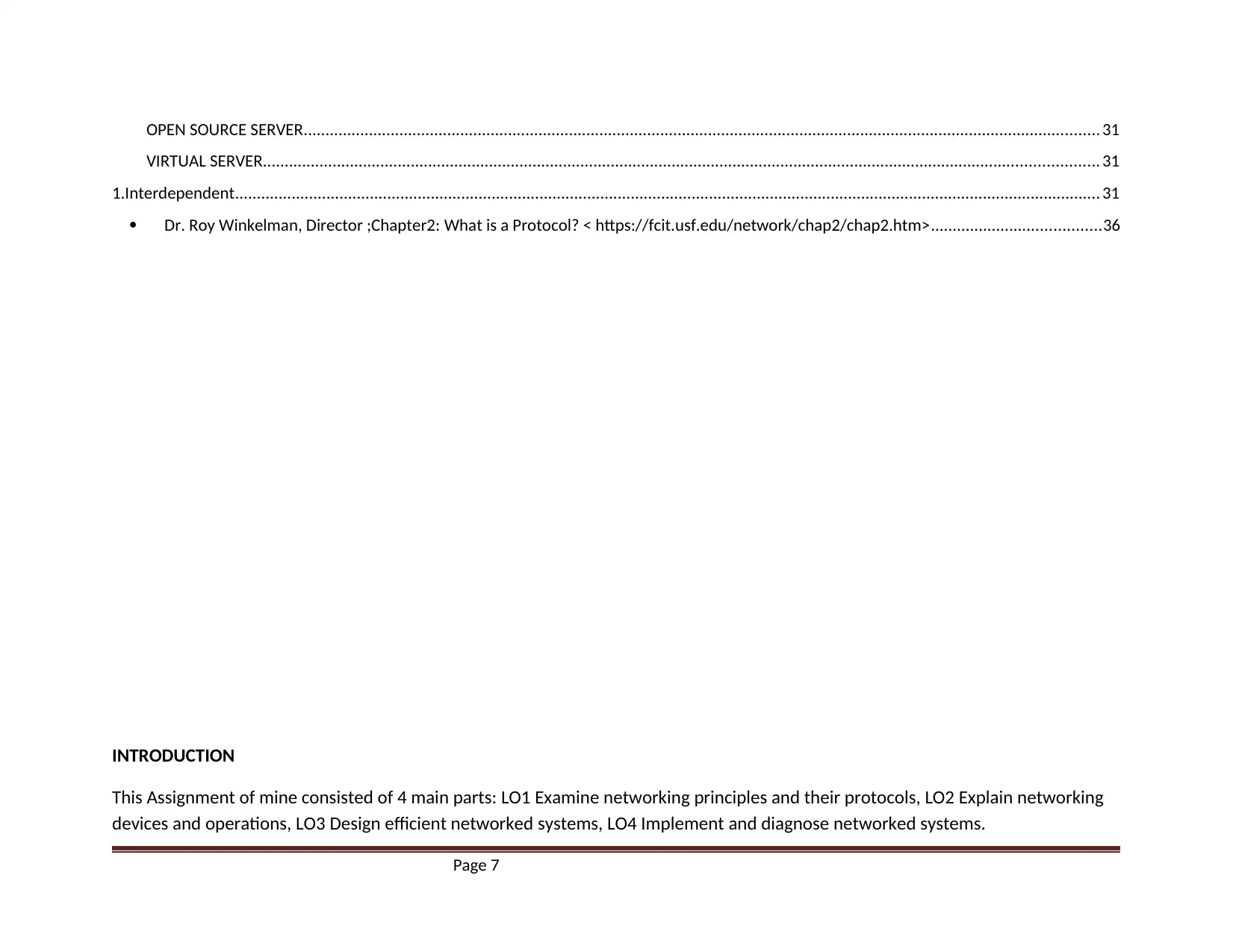
OPEN SOURCE SERVER....................................................................................................................................................................................... 31
VIRTUAL SERVER................................................................................................................................................................................................ 31
1.Interdependent....................................................................................................................................................................................................... 31
Dr. Roy Winkelman, Director ;Chapter2: What is a Protocol? < https://fcit.usf.edu/network/chap2/chap2.htm>.......................................36
INTRODUCTION
This Assignment of mine consisted of 4 main parts: LO1 Examine networking principles and their protocols, LO2 Explain networking
devices and operations, LO3 Design efficient networked systems, LO4 Implement and diagnose networked systems.
Page 7
VIRTUAL SERVER................................................................................................................................................................................................ 31
1.Interdependent....................................................................................................................................................................................................... 31
Dr. Roy Winkelman, Director ;Chapter2: What is a Protocol? < https://fcit.usf.edu/network/chap2/chap2.htm>.......................................36
INTRODUCTION
This Assignment of mine consisted of 4 main parts: LO1 Examine networking principles and their protocols, LO2 Explain networking
devices and operations, LO3 Design efficient networked systems, LO4 Implement and diagnose networked systems.
Page 7
Paraphrase This Document
Need a fresh take? Get an instant paraphrase of this document with our AI Paraphraser
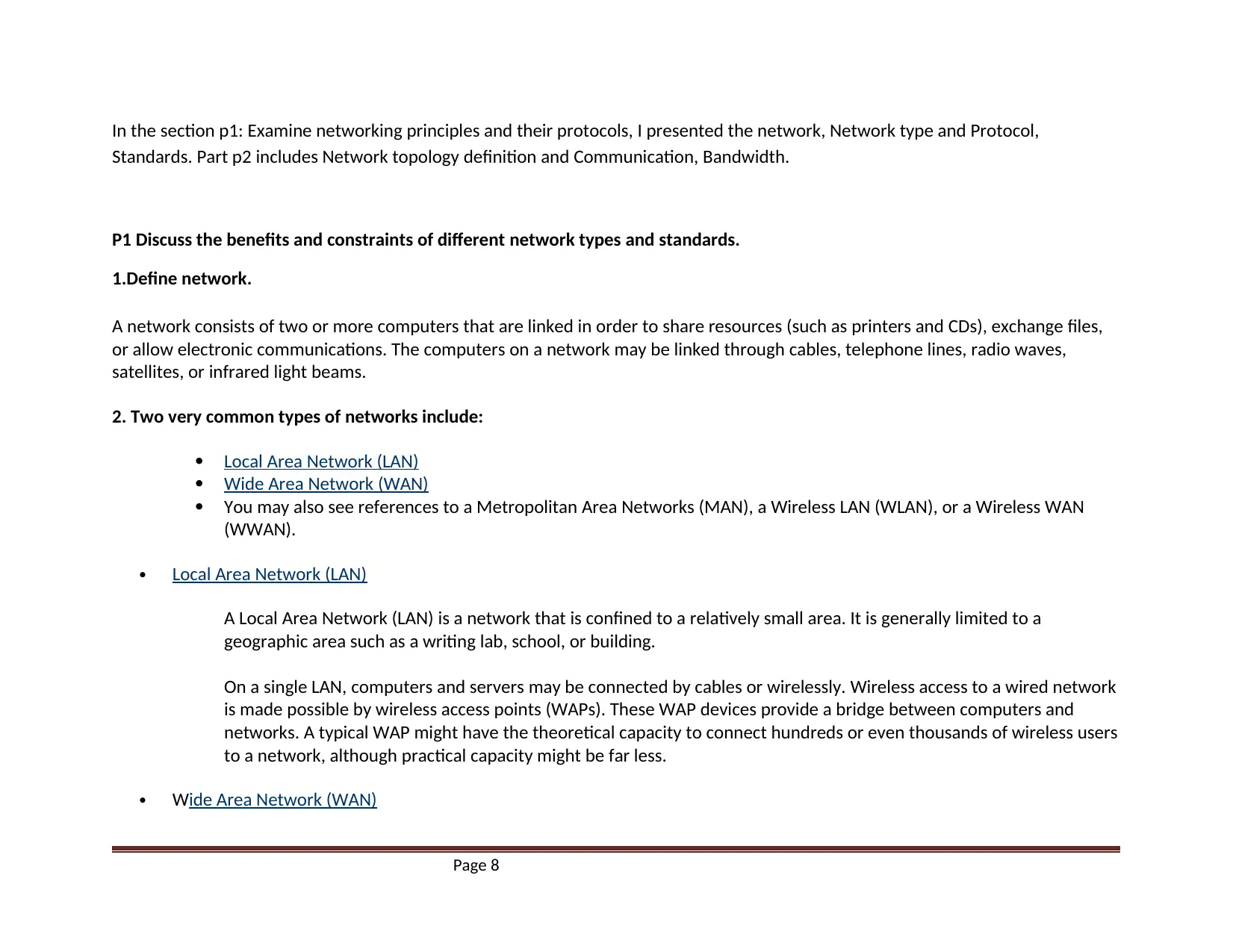
In the section p1: Examine networking principles and their protocols, I presented the network, Network type and Protocol,
Standards. Part p2 includes Network topology definition and Communication, Bandwidth.
P1 Discuss the benefits and constraints of different network types and standards.
1.Define network.
A network consists of two or more computers that are linked in order to share resources (such as printers and CDs), exchange files,
or allow electronic communications. The computers on a network may be linked through cables, telephone lines, radio waves,
satellites, or infrared light beams.
2. Two very common types of networks include:
Local Area Network (LAN)
Wide Area Network (WAN)
You may also see references to a Metropolitan Area Networks (MAN), a Wireless LAN (WLAN), or a Wireless WAN
(WWAN).
Local Area Network (LAN)
A Local Area Network (LAN) is a network that is confined to a relatively small area. It is generally limited to a
geographic area such as a writing lab, school, or building.
On a single LAN, computers and servers may be connected by cables or wirelessly. Wireless access to a wired network
is made possible by wireless access points (WAPs). These WAP devices provide a bridge between computers and
networks. A typical WAP might have the theoretical capacity to connect hundreds or even thousands of wireless users
to a network, although practical capacity might be far less.
Wide Area Network (WAN)
Page 8
Standards. Part p2 includes Network topology definition and Communication, Bandwidth.
P1 Discuss the benefits and constraints of different network types and standards.
1.Define network.
A network consists of two or more computers that are linked in order to share resources (such as printers and CDs), exchange files,
or allow electronic communications. The computers on a network may be linked through cables, telephone lines, radio waves,
satellites, or infrared light beams.
2. Two very common types of networks include:
Local Area Network (LAN)
Wide Area Network (WAN)
You may also see references to a Metropolitan Area Networks (MAN), a Wireless LAN (WLAN), or a Wireless WAN
(WWAN).
Local Area Network (LAN)
A Local Area Network (LAN) is a network that is confined to a relatively small area. It is generally limited to a
geographic area such as a writing lab, school, or building.
On a single LAN, computers and servers may be connected by cables or wirelessly. Wireless access to a wired network
is made possible by wireless access points (WAPs). These WAP devices provide a bridge between computers and
networks. A typical WAP might have the theoretical capacity to connect hundreds or even thousands of wireless users
to a network, although practical capacity might be far less.
Wide Area Network (WAN)
Page 8
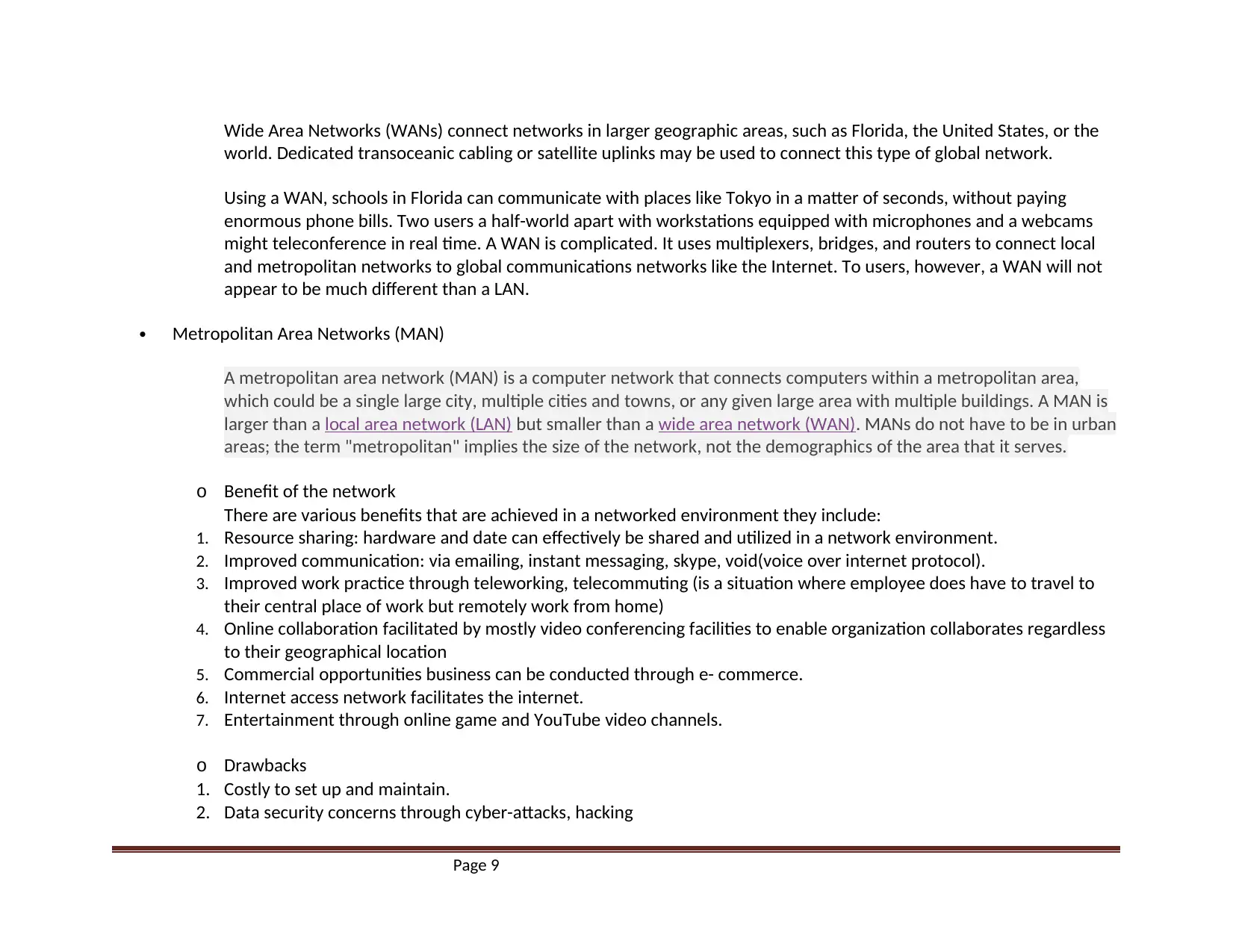
Wide Area Networks (WANs) connect networks in larger geographic areas, such as Florida, the United States, or the
world. Dedicated transoceanic cabling or satellite uplinks may be used to connect this type of global network.
Using a WAN, schools in Florida can communicate with places like Tokyo in a matter of seconds, without paying
enormous phone bills. Two users a half-world apart with workstations equipped with microphones and a webcams
might teleconference in real time. A WAN is complicated. It uses multiplexers, bridges, and routers to connect local
and metropolitan networks to global communications networks like the Internet. To users, however, a WAN will not
appear to be much different than a LAN.
Metropolitan Area Networks (MAN)
A metropolitan area network (MAN) is a computer network that connects computers within a metropolitan area,
which could be a single large city, multiple cities and towns, or any given large area with multiple buildings. A MAN is
larger than a local area network (LAN) but smaller than a wide area network (WAN). MANs do not have to be in urban
areas; the term "metropolitan" implies the size of the network, not the demographics of the area that it serves.
o Benefit of the network
There are various benefits that are achieved in a networked environment they include:
1. Resource sharing: hardware and date can effectively be shared and utilized in a network environment.
2. Improved communication: via emailing, instant messaging, skype, void(voice over internet protocol).
3. Improved work practice through teleworking, telecommuting (is a situation where employee does have to travel to
their central place of work but remotely work from home)
4. Online collaboration facilitated by mostly video conferencing facilities to enable organization collaborates regardless
to their geographical location
5. Commercial opportunities business can be conducted through e- commerce.
6. Internet access network facilitates the internet.
7. Entertainment through online game and YouTube video channels.
o Drawbacks
1. Costly to set up and maintain.
2. Data security concerns through cyber-attacks, hacking
Page 9
world. Dedicated transoceanic cabling or satellite uplinks may be used to connect this type of global network.
Using a WAN, schools in Florida can communicate with places like Tokyo in a matter of seconds, without paying
enormous phone bills. Two users a half-world apart with workstations equipped with microphones and a webcams
might teleconference in real time. A WAN is complicated. It uses multiplexers, bridges, and routers to connect local
and metropolitan networks to global communications networks like the Internet. To users, however, a WAN will not
appear to be much different than a LAN.
Metropolitan Area Networks (MAN)
A metropolitan area network (MAN) is a computer network that connects computers within a metropolitan area,
which could be a single large city, multiple cities and towns, or any given large area with multiple buildings. A MAN is
larger than a local area network (LAN) but smaller than a wide area network (WAN). MANs do not have to be in urban
areas; the term "metropolitan" implies the size of the network, not the demographics of the area that it serves.
o Benefit of the network
There are various benefits that are achieved in a networked environment they include:
1. Resource sharing: hardware and date can effectively be shared and utilized in a network environment.
2. Improved communication: via emailing, instant messaging, skype, void(voice over internet protocol).
3. Improved work practice through teleworking, telecommuting (is a situation where employee does have to travel to
their central place of work but remotely work from home)
4. Online collaboration facilitated by mostly video conferencing facilities to enable organization collaborates regardless
to their geographical location
5. Commercial opportunities business can be conducted through e- commerce.
6. Internet access network facilitates the internet.
7. Entertainment through online game and YouTube video channels.
o Drawbacks
1. Costly to set up and maintain.
2. Data security concerns through cyber-attacks, hacking
Page 9
⊘ This is a preview!⊘
Do you want full access?
Subscribe today to unlock all pages.

Trusted by 1+ million students worldwide
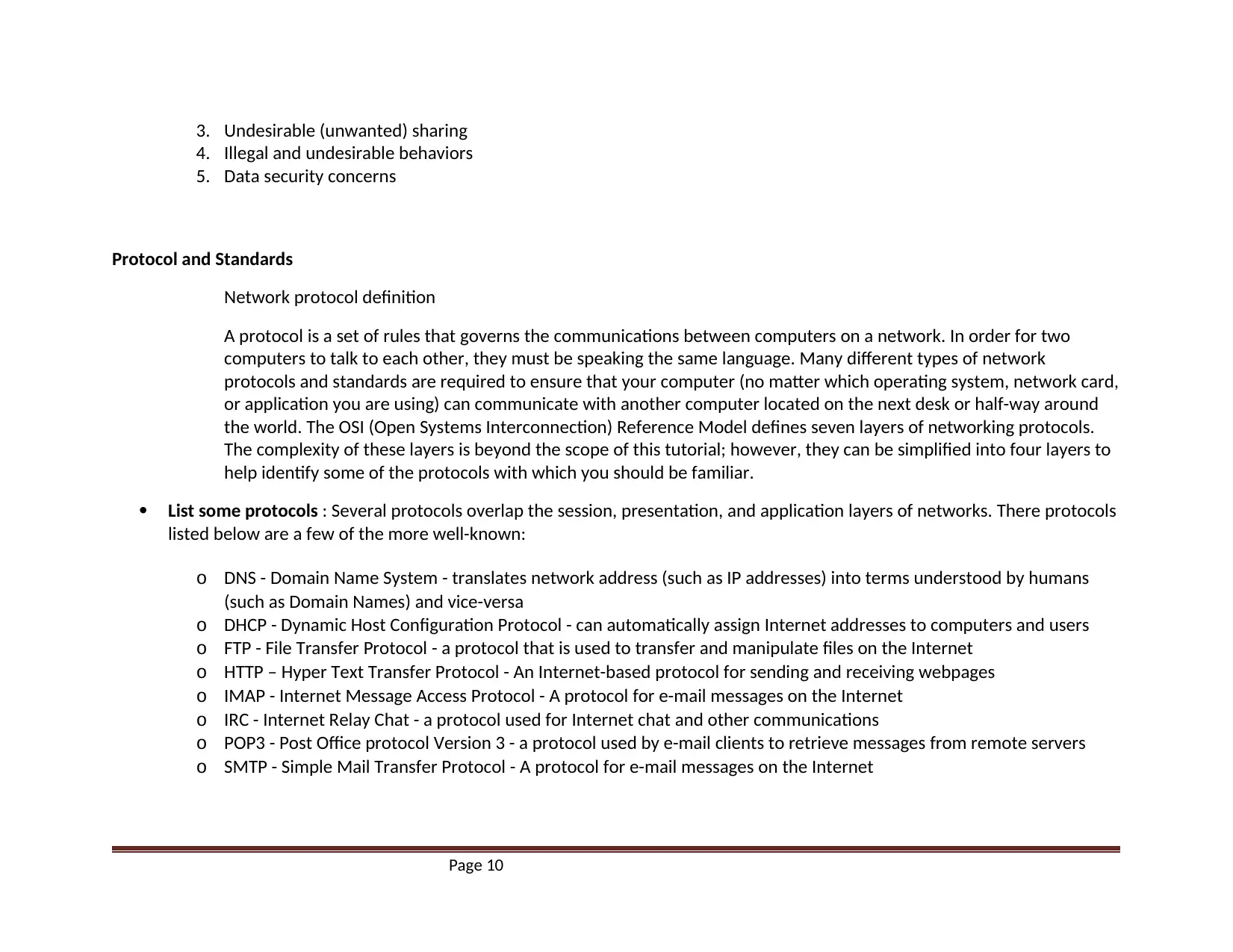
3. Undesirable (unwanted) sharing
4. Illegal and undesirable behaviors
5. Data security concerns
Protocol and Standards
Network protocol definition
A protocol is a set of rules that governs the communications between computers on a network. In order for two
computers to talk to each other, they must be speaking the same language. Many different types of network
protocols and standards are required to ensure that your computer (no matter which operating system, network card,
or application you are using) can communicate with another computer located on the next desk or half-way around
the world. The OSI (Open Systems Interconnection) Reference Model defines seven layers of networking protocols.
The complexity of these layers is beyond the scope of this tutorial; however, they can be simplified into four layers to
help identify some of the protocols with which you should be familiar.
List some protocols : Several protocols overlap the session, presentation, and application layers of networks. There protocols
listed below are a few of the more well-known:
o DNS - Domain Name System - translates network address (such as IP addresses) into terms understood by humans
(such as Domain Names) and vice-versa
o DHCP - Dynamic Host Configuration Protocol - can automatically assign Internet addresses to computers and users
o FTP - File Transfer Protocol - a protocol that is used to transfer and manipulate files on the Internet
o HTTP – Hyper Text Transfer Protocol - An Internet-based protocol for sending and receiving webpages
o IMAP - Internet Message Access Protocol - A protocol for e-mail messages on the Internet
o IRC - Internet Relay Chat - a protocol used for Internet chat and other communications
o POP3 - Post Office protocol Version 3 - a protocol used by e-mail clients to retrieve messages from remote servers
o SMTP - Simple Mail Transfer Protocol - A protocol for e-mail messages on the Internet
Page 10
4. Illegal and undesirable behaviors
5. Data security concerns
Protocol and Standards
Network protocol definition
A protocol is a set of rules that governs the communications between computers on a network. In order for two
computers to talk to each other, they must be speaking the same language. Many different types of network
protocols and standards are required to ensure that your computer (no matter which operating system, network card,
or application you are using) can communicate with another computer located on the next desk or half-way around
the world. The OSI (Open Systems Interconnection) Reference Model defines seven layers of networking protocols.
The complexity of these layers is beyond the scope of this tutorial; however, they can be simplified into four layers to
help identify some of the protocols with which you should be familiar.
List some protocols : Several protocols overlap the session, presentation, and application layers of networks. There protocols
listed below are a few of the more well-known:
o DNS - Domain Name System - translates network address (such as IP addresses) into terms understood by humans
(such as Domain Names) and vice-versa
o DHCP - Dynamic Host Configuration Protocol - can automatically assign Internet addresses to computers and users
o FTP - File Transfer Protocol - a protocol that is used to transfer and manipulate files on the Internet
o HTTP – Hyper Text Transfer Protocol - An Internet-based protocol for sending and receiving webpages
o IMAP - Internet Message Access Protocol - A protocol for e-mail messages on the Internet
o IRC - Internet Relay Chat - a protocol used for Internet chat and other communications
o POP3 - Post Office protocol Version 3 - a protocol used by e-mail clients to retrieve messages from remote servers
o SMTP - Simple Mail Transfer Protocol - A protocol for e-mail messages on the Internet
Page 10
Paraphrase This Document
Need a fresh take? Get an instant paraphrase of this document with our AI Paraphraser
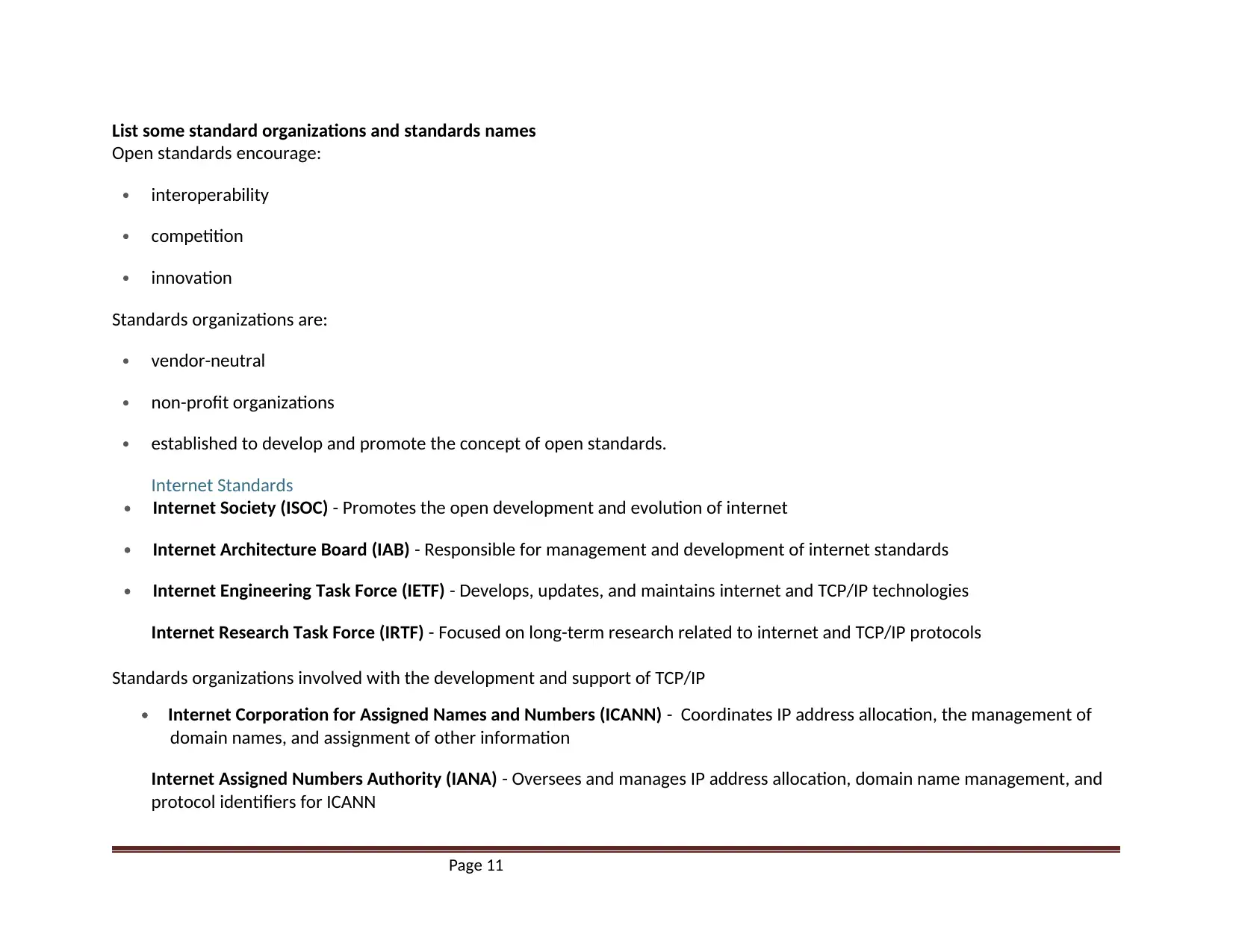
List some standard organizations and standards names
Open standards encourage:
interoperability
competition
innovation
Standards organizations are:
vendor-neutral
non-profit organizations
established to develop and promote the concept of open standards.
Internet Standards
Internet Society (ISOC) - Promotes the open development and evolution of internet
Internet Architecture Board (IAB) - Responsible for management and development of internet standards
Internet Engineering Task Force (IETF) - Develops, updates, and maintains internet and TCP/IP technologies
Internet Research Task Force (IRTF) - Focused on long-term research related to internet and TCP/IP protocols
Standards organizations involved with the development and support of TCP/IP
Internet Corporation for Assigned Names and Numbers (ICANN) - Coordinates IP address allocation, the management of
domain names, and assignment of other information
Internet Assigned Numbers Authority (IANA) - Oversees and manages IP address allocation, domain name management, and
protocol identifiers for ICANN
Page 11
Open standards encourage:
interoperability
competition
innovation
Standards organizations are:
vendor-neutral
non-profit organizations
established to develop and promote the concept of open standards.
Internet Standards
Internet Society (ISOC) - Promotes the open development and evolution of internet
Internet Architecture Board (IAB) - Responsible for management and development of internet standards
Internet Engineering Task Force (IETF) - Develops, updates, and maintains internet and TCP/IP technologies
Internet Research Task Force (IRTF) - Focused on long-term research related to internet and TCP/IP protocols
Standards organizations involved with the development and support of TCP/IP
Internet Corporation for Assigned Names and Numbers (ICANN) - Coordinates IP address allocation, the management of
domain names, and assignment of other information
Internet Assigned Numbers Authority (IANA) - Oversees and manages IP address allocation, domain name management, and
protocol identifiers for ICANN
Page 11
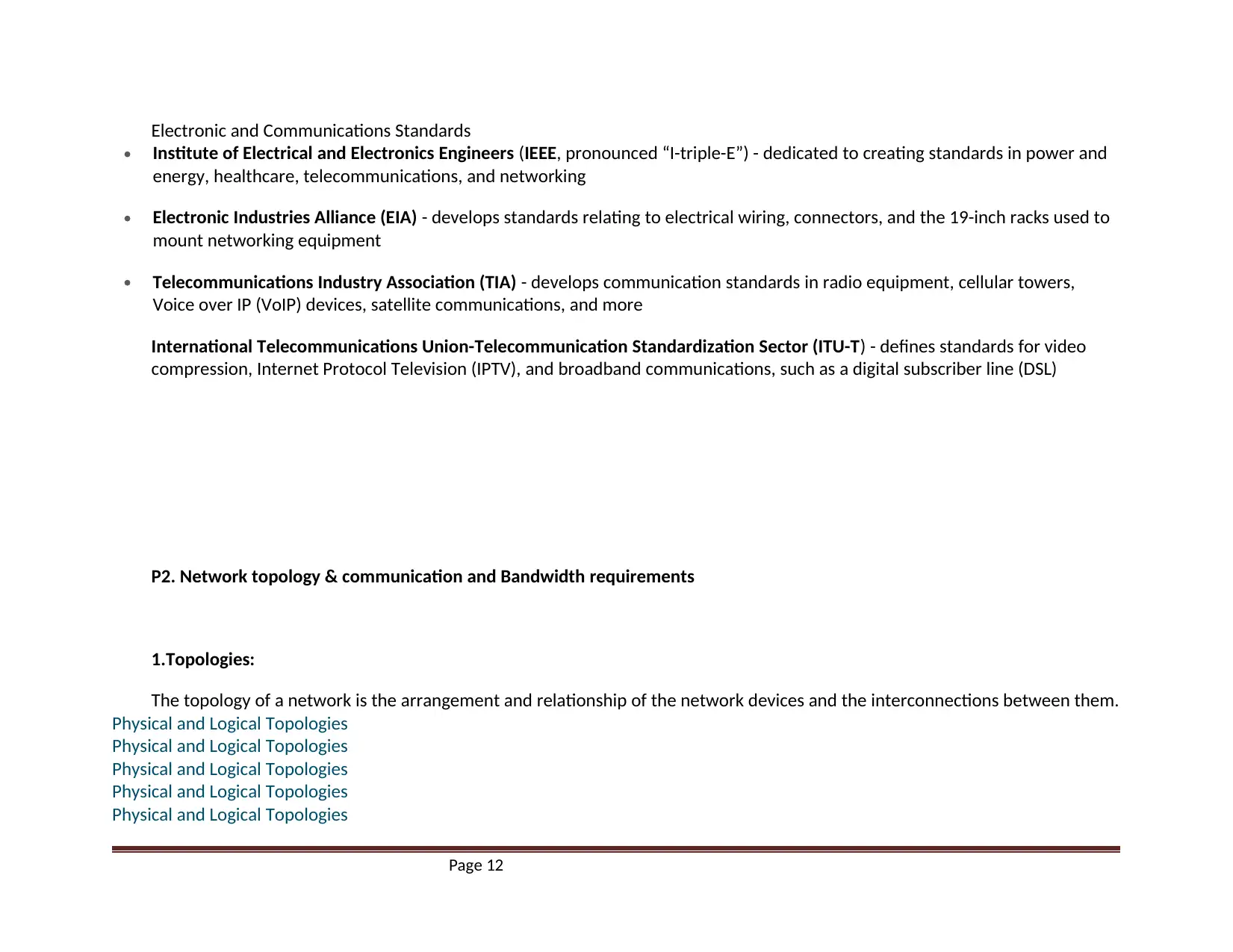
Electronic and Communications Standards
Institute of Electrical and Electronics Engineers (IEEE, pronounced “I-triple-E”) - dedicated to creating standards in power and
energy, healthcare, telecommunications, and networking
Electronic Industries Alliance (EIA) - develops standards relating to electrical wiring, connectors, and the 19-inch racks used to
mount networking equipment
Telecommunications Industry Association (TIA) - develops communication standards in radio equipment, cellular towers,
Voice over IP (VoIP) devices, satellite communications, and more
International Telecommunications Union-Telecommunication Standardization Sector (ITU-T) - defines standards for video
compression, Internet Protocol Television (IPTV), and broadband communications, such as a digital subscriber line (DSL)
P2. Network topology & communication and Bandwidth requirements
1.Topologies:
The topology of a network is the arrangement and relationship of the network devices and the interconnections between them.
Physical and Logical Topologies
Physical and Logical Topologies
Physical and Logical Topologies
Physical and Logical Topologies
Physical and Logical Topologies
Page 12
Institute of Electrical and Electronics Engineers (IEEE, pronounced “I-triple-E”) - dedicated to creating standards in power and
energy, healthcare, telecommunications, and networking
Electronic Industries Alliance (EIA) - develops standards relating to electrical wiring, connectors, and the 19-inch racks used to
mount networking equipment
Telecommunications Industry Association (TIA) - develops communication standards in radio equipment, cellular towers,
Voice over IP (VoIP) devices, satellite communications, and more
International Telecommunications Union-Telecommunication Standardization Sector (ITU-T) - defines standards for video
compression, Internet Protocol Television (IPTV), and broadband communications, such as a digital subscriber line (DSL)
P2. Network topology & communication and Bandwidth requirements
1.Topologies:
The topology of a network is the arrangement and relationship of the network devices and the interconnections between them.
Physical and Logical Topologies
Physical and Logical Topologies
Physical and Logical Topologies
Physical and Logical Topologies
Physical and Logical Topologies
Page 12
⊘ This is a preview!⊘
Do you want full access?
Subscribe today to unlock all pages.

Trusted by 1+ million students worldwide
1 out of 31
Related Documents
Your All-in-One AI-Powered Toolkit for Academic Success.
+13062052269
info@desklib.com
Available 24*7 on WhatsApp / Email
![[object Object]](/_next/static/media/star-bottom.7253800d.svg)
Unlock your academic potential
Copyright © 2020–2025 A2Z Services. All Rights Reserved. Developed and managed by ZUCOL.





